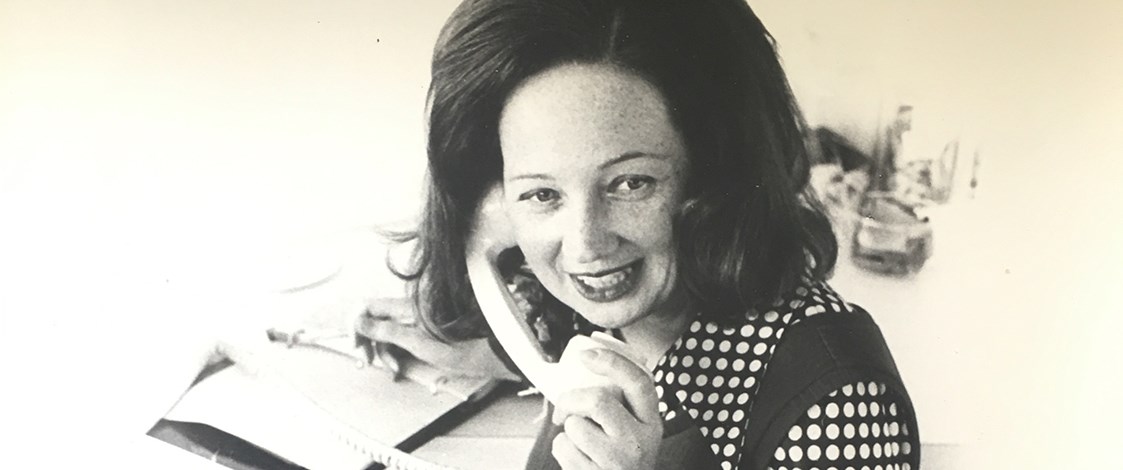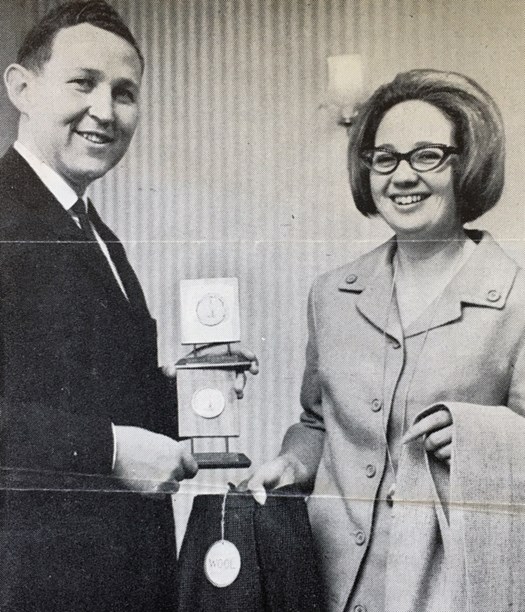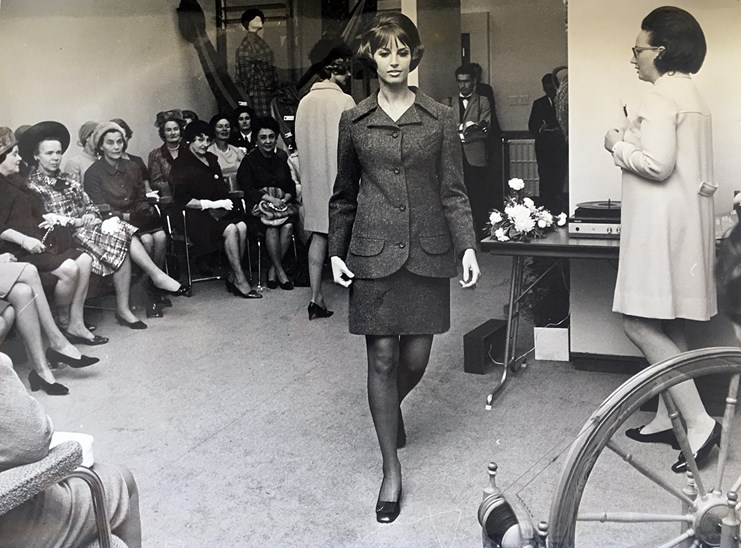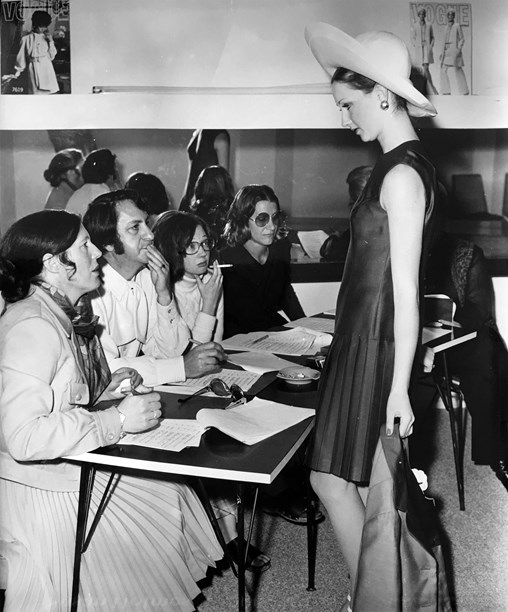Stories
Jillian Ewart
1940-

Jillian Ewart’s role as the New Zealand Wool Board’s fashion adviser during the 1960s gave her an entrée into the European fashion scene. It also gave her a strong influence on what New Zealand women would wear during that decade.
For a young woman of 23, meeting her International Wool Secretariat (IWS) counterparts from Europe and North America and viewing the latest collections from the topmost Parisian fashion houses, was both thrilling and nerve-wracking.
An enthusiastic and possibly envious local journalist was moved to report that: "After three days in Paris she found herself able to hitch her skirt a little higher, open her eyes a bit wider and stare with unabashed and undisguised interest at what paraded before her." (Southland Daily News, 19 March 1966). Jillian herself remembers that sitting in a gilt curlicue seat in a famous atelier in Paris – albeit in the back row– was indeed an enormous adventure.

As the Wool Board representative, Jillian presented the Wool Board medals to winning designers and manufacturers, including Sportscraft's John Stohr.
During her six-year stint with the New Zealand Wool Board, Jillian travelled to Paris every second year. At that time local designers did not travel to Paris as a matter of course, so her "Paris Reports" were of vital importance to New Zealand fashion designers and manufacturers.
At a preview of the Yves Saint Laurent collection one year she glimpsed the great designer with his mop of almost Beatle-like hair and huge trademark glasses popping worriedly in and out of his offices. Another time she was seated in an atelier not far from Marlene Dietrich, noting that she was, perhaps a little tactlessly, wearing a Chanel suit at a Balmain show. "The IWS was really big in the early 1960s promoting fine wool to the world. The secretariat had an amazing public relations set up – they actually had a fashion unit in Paris," she says.
Wool, though fighting for prominence over new synthetics in the 1960s, still ruled the Paris collections. In 1966 Jillian reported that wool was used for virtually every outfit in the Winter Collection including Dior, Lanvin and Yves Saint Laurent.
Back in her Wellington office she would create a roadshow which included slides of the latest couturier fashions, sketches and colour swatch boards provided by the IWS. Those boards were then used by local designers and manufacturers as the basis for their season’s designs.
Always fashion conscious, Jillian’s journey into the New Zealand fashion world came through journalism. She was recruited by the weekly newspaper Truth, where she quickly progressed from typing letters to the reporters’ pool. As a tabloid Truth seemed an unlikely proving ground for fashion writing. But amid court reports and local scandals, Jillian found it easy enough to create a fashion page. It wasn’t very long however, before she decided to do her OE and took off for London.
In a roundabout and somewhat ironic way it was one of her early Truth contacts with Fibremakers, a synthetic fabrics factory in Shannon, that led to her Wool Board appointment. "They gave me an intro to their London office while I was trying to find a job. Their London people said, 'You’re from New Zealand, you should see the International Wool Secretariat.' The guy who saw me there said, 'We haven’t got anything here, but if you’re thinking of going back to New Zealand we know they want somebody!'"
She caught a plane home to Wellington and within a fortnight became that somebody. Two days later she found herself in Auckland organising the Wool Board’s trade and public showing of garments for the following year. The local part of her job involved mounting fashion publicity campaigns and organising wool fashion parades and events. "You just needed a lot of chutzpah or blind ignorance," she laughs, looking back on those rather heady times.

Jillian, right, compering a fashion show, 1960s.
In her first year on the job she was a judge for the Miss New Zealand show. That year’s winner was Elaine Miscall, who, like Jillian and 1960s top model, Josephine Brodie, was a former pupil of St Mary’s College in Wellington. She remembers that a fellow judge, artist Shona McFarlane, wore a white beaded top with a black skirt, while Jillian had on a black beaded top with a white skirt. Wool of course!
During her time with the Wool Board, Jillian supervised the all wool wardrobes of five Miss New Zealands and in 1969 that of New Zealand’s Pastoral Queen, Janet Craigie of Gore.
Having celebrities wearing wool, profiled designers as well as the fabric itself. During a series of overseas promotional performances, a young Kiri Te Kanawa wore a white wool chiffon Tarantella gown with a cape by Joan Talbot, commissioned by the Wool Board.
The IWS sent their 'ambassadress' Miss World 1965 Ann Sidney from the UK to be a guest model at the Wool Board Awards where dozens of local designers competed to have their garments shown. Other attention-drawing beauties included Barbara Petsel, 1967 'Miss Wool of America'. As chaperone during her New Zealand stay, Jillian was astounded by the sheer size of Barbara’s promotional wardrobe.
Each winter the Wool Board mounted a major fashion campaign with advertising agency Carlton Carruthers. By the mid-sixties the innovative style of emerging fashion photographer, Desmond Williams, was a key to the success of these campaigns. "I recall some marvellous shots that Des Williams did for one ad campaign where he triple exposed shots of three women – Vicky Overton, Judith Baragwanath and Anne McClurg – in the same three garments. I don’t know how he did it. He was very ahead of his time," Jillian recalls.
Jillian’s job also saw her taking her pick from local designer collections for fashion shoots, among them Colin Cole, Joan Talbot, Bernard Zeff from Selby, El Jay and Miss Deb.
"You never really knew what you would be doing next," she laughs. She recalls being asked by her boss at the end of a very long day in Auckland in 1965 to urgently find five woollen baby shawls. He’d just remembered a promise to Shirley Lawson, mother of the newly born quintuplets, that the Wool Board would provide shawls for these high profile babies to travel from hospital to home in style. Jillian’s quick call to Smith & Caughey's department store at 5.30pm fixed the problem.
As for her own wardrobe, she was expected of course, to wear wool – cotton in summer, but always natural fabrics. "I had a Courreges knock off pantsuit that I loved to bits. It was camel, with a cream detail but it was pants, which were hardly ever seen at that time."
There were also a few clothing perks. "The IWS would buy a few key pieces and then when they were past their "use by" date there was an opportunity to acquire them. I had a wonderful Phillipe Venet tapestry A-line coat in purple and parma tones with beautiful hand-painted buttons that I later donated to the Wellington Polytechnic fashion class."
By 1970 Jillian had moved to Auckland where she worked for a year as assistant editor for fashion trade magazine, Apparel. After a period of freelance journalism she moved to a job on the innovative Thursday – an antidote to the more traditional women’s magazines. Fashion still had its place and Jillian used her talents to coordinate the fashion pages as well as other feature writing, including an award-winning series on 'Women and Money'.

Jillian Ewart (third from left) with designer Michael Mattar and the Auckland Star’s Val Blomfield (far right) judging a garment worn by model Jane Daniels.
In 1975 Jillian’s career took a new direction. She moved into television, training as a director and producer. From 1980-1988 she was the producer of the highly successful arts programme Kaleidoscope. Still in touch with the world of fashion, she also developed the format for the live Benson & Hedges Fashion Design Awards, which TVNZ screened as an annual live-to-air show from 1984 to 1998. (When tobacco company sponsorship was outlawed it became the Smokefree Fashion Design Awards). Jillian produced seven of these shows, overlapping by the late 1980s with another career change, this time as the owner of a specialist bookshop in the Auckland beach suburb of Milford.
These days she lives in a stylish Bay of Plenty village apartment and reflects on her fashion days with affection. She hasn’t kept any of her 60s-era wool wardrobe, preferring to buy new but classic styles. But she does sometimes wonder if that favourite Philippe Venet coat still exists. "More likely," she laughs, "someone cut it up for hot pants in the seventies."
Text by Katherine Findlay. Banner image by Michael Gillies for Eve magazine. Image © Eve magazine.
Last published March 2018.